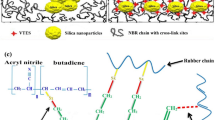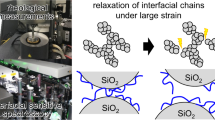Abstract
We demonstrate the preparation and unique properties of composite vitrimer-like materials containing silica nanoparticles (SNPs). The matrix is composed of polyacrylate-based polymers crosslinked via a pyridine–bromo quaternization reaction, where the quaternized pyridine at the crosslinking point exchanges the bond pair via trans-N-alkylation at high temperatures. Homogeneous composite samples without a large aggregation of SNPs were prepared within the silica volume fraction range (ϕP) from 0.06 to 0.36. The formation of the bound rubber phase and the strong adhesion between the SNP and matrix are admitted in the data from structural, thermal, and mechanical investigations. The crosslinked composites exhibit great stress relaxation at high temperatures because of bond exchange, wherein unique bimodal relaxation behaviors are observed for the samples with high ϕP because of the bound rubber phase. In the final section, some useful functions, such as reprocessability and recyclability, derived from the bond exchange nature are exhibited.
This is a preview of subscription content, access via your institution
Access options
Subscribe to this journal
Receive 12 print issues and online access
$259.00 per year
only $21.58 per issue
Buy this article
- Purchase on Springer Link
- Instant access to full article PDF
Prices may be subject to local taxes which are calculated during checkout









Similar content being viewed by others
References
Himenz PC, Lodge TP. Polymer chemistry. 2nd ed. Boca Raton: CRC Press; 2007.
Wojtecki RJ, Meador MA, Rowan SJ. Using the dynamic bond to access macroscopically responsive structurally dynamic polymers. Nat Mater. 2011;10:14–27.
Zou WK, Dong JT, Luo YW, Zhao Q, Xie T. Dynamic covalent polymer networks: from old chemistry to modern day innovations. Adv Mater. 2017;29:1606100.
Zhang ZP, Rong MZ, Zhang MQ. Polymer engineering based on reversible covalent chemistry: a promising innovative pathway towards new materials and new functionalities. Prog Polym Sci. 2018;80:39–93.
Chakma P, Konkolewicz D. Dynamic covalent bonds in polymeric materials. Angew Chem Int Ed. 2019;58:9682–95.
Zheng N, Xu Y, Zhao Q, Xie T. Dynamic covalent polymer networks: a molecular platform for designing functions beyond chemical recycling and self-healing. Chem Rev. 2021;121:1716–45.
Chen XX, Dam MA, Ono K, Mal A, Shen HB, Nutt SR. et al. A thermally re-mendable cross-linked polymeric material. Science. 2002;295:1698–702.
Otsuka H. Reorganization of polymer structures based on dynamic covalent chemistry: polymer reactions by dynamic covalent exchanges of alkoxyamine units. Polym J. 2013;45:879–91.
Liu T, Zhao BM, Zhang JW. Recent development of repairable, malleable and recyclable thermosetting polymers through dynamic transesterification. Polymer. 2020;194:122392.
Montarnal D, Capelot M, Tournilhac F, Leibler L. Silica-like malleable materials from permanent organic networks. Science. 2011;334:965–8.
Winne JM, Leibler L, Du Prez FE. Dynamic covalent chemistry in polymer networks: a mechanistic perspective. Polym Chem. 2019;10:6091–108.
Capelot M, Unterlass MM, Tournilhac F, Leibler L. Catalytic control of the vitrimer glass transition. ACS Macro Lett. 2012;1:789–92.
Capelot M, Montarnal D, Tournilhac F, Leibler L. Metal-catalyzed transesterification for healing and assembling of thermosets. J Am Chem Soc. 2012;134:7664–7.
Schoustra SK, Dijksman JA, Zuilhof H, Smulders MMJ. Molecular control over vitrimer-like mechanics – tuneable dynamic motifs based on the Hammett equation in polyimine materials. Chem Sci. 2021;12:293–302.
Fan CJ, Wen ZB, Xu ZY, Xiao Y, Wu D, Yang KK. et al. Adaptable strategy to fabricate self-healable and reprocessable poly(thiourethane-urethane) elastomers via reversible thiol-isocyanate click chemistry. Macromolecules. 2020;53:4284–93.
Snyder RL, Lidston CAL, De Hoe GX, Parvulescu MJS, Hillmyer MA, Coates GW. Mechanically robust and reprocessable imine exchange networks from modular polyester pre-polymers. Polym Chem. 2020;11:5346–55.
Chakma P, Morley CN, Sparks JL, Konkolewicz D. Exploring how vitrimer-like properties can be achieved from dissociative exchange in anilinium salts. Macromolecules. 2020;53:1233–44.
Obadia MM, Jourdain A, Cassagnau P, Montarnal D, Drockenmuller E. Tuning the viscosity profile of ionic vitrimers incorporating 1,2,3-triazolium cross-links. Adv Funct Mater. 2017;27:1703258.
Scheutz GM, Lessard JJ, Sims MB, Sumerlin BS. Adaptable crosslinks in polymeric materials: resolving the intersection of thermoplastics and thermosets. J Am Chem Soc. 2019;141:16181–96.
Elling BR, Dichtel WR. Reprocessable cross-linked polymer networks: are associative exchange mechanisms desirable? ACS Cent Sci. 2020;6:1488–96.
Hayashi M. Implantation of recyclability and healability into cross-linked commercial polymers by applying the vitrimer concept. Polymers. 2020;12:1322.
Podgorski M, Fairbanks BD, Kirkpatrick BE, McBride M, Martinez A, Dobson A. et al. Toward stimuli-responsive dynamic thermosets through continuous development and improvements in Covalent Adaptable Networks (CANs). Adv Mater. 2020;32:1906876
Hayashi M, Yano R, Takasu A. Synthesis of amorphous low T-g polyesters with multiple COOH side groups and their utilization for elastomeric vitrimers based on post-polymerization cross-linking. Polym Chem. 2019;10:2047–56.
Hayashi M, Yano R. Fair investigation of cross-link density effects on the bond-exchange properties for trans-esterification-based vitrimers with identical concentrations of reactive groups. Macromolecules. 2020;53:182–9.
Hayashi M. Dominant factor of bond-exchange rate for catalyst-free polyester vitrimers with internal tertiary amine moieties. ACS Appl Polym Mater. 2020;2:5365–70.
Chen M, Si HW, Zhang H, Zhou L, Wu YP, Song LX. et al. The crucial role in controlling the dynamic properties of polyester-based epoxy vitrimers: the density of exchangeable ester bonds (nu). Macromolecules. 2021;54:10110–7.
Hayashi M, Oba Y, Kimura T, Takasu A. Simple preparation, properties, and functions of vitrimer-like polyacrylate elastomers using trans-N-alkylation bond exchange. Polym J. 2021;53:835–40.
Kaiser S, Jandl J, Novak P, Schlogl S. Design and characterisation of vitrimer-like elastomeric composites from HXNBR rubber. Soft Matter. 2020;16:8577–90.
Liu YJ, Tang ZH, Chen Y, Zhang CF, Guo BC. Engineering of beta-hydroxyl esters into elastomer-nanoparticle interface toward malleable, robust, and reprocessable vitrimer composites. ACS Appl Mater Interfaces. 2018;10:2992–3001.
Tang ZH, Liu YJ, Guo BC, Zhang LQ. Malleable, mechanically strong, and adaptive elastomers enabled by interfacial exchangeable bonds. Macromolecules. 2017;50:7584–92.
Legrand A, Soulie-Ziakovic C. Silica-epoxy vitrimer nanocomposites. Macromolecules. 2016;49:5893–902.
Chen X, Li LQ, Wei T. Venerus DC, Torkelson JM. Reprocessable polyhydroxyurethane network composites: effect of filler surface functionality on cross-link density recovery and stress relaxation. ACS Appl Mater Interfaces. 2019;11:2398–407.
Mun GA, Nurkeeva ZS, Beissegul AB, Dubolazov AV, Urkimbaeva PI, Park K. et al. Temperature-responsive water-soluble copolymers based on 2-hydroxyethyl acrylate and butyl acrylate. Macromol Chem Phys. 2007;208:979–87.
Kato K, Matsui D, Mayumi K, Ito K. Synthesis, structure, and mechanical properties of silica nanocomposite polyrotaxane gels. Beilstein J Org Chem. 2015;11:2194–201.
Zhang H, Zhang Z, Friedrich K, Eger C. Property improvements of in situ epoxy nanocomposites with reduced interparticle distance at high nanosilica content. Acta Mater. 2006;54:1833–42.
Chevigny C, Jouault N, Dalmas F, Boue F, Jestin J. Tuning the mechanical properties in model nanocomposites: influence of the polymer-filler interfacial interactions. J Polym Sci Pt B-Polym Phys. 2011;49:781–91.
Inoue T, Narihisa Y, Katashima T, Kawasaki S, Tada T. A Rheo-optical study on reinforcement effect of silica particle filled rubber. Macromolecules. 2017;50:8072–82.
Asai F, Seki T, Hoshino T, Liang XB, Nakajima K, Takeoka Y. Silica nanoparticle reinforced composites as transparent elastomeric damping materials. ACS Appl Nano Mater. 2021;4:4140–52.
Lewis TB, Nielsen LE. Dynamic mechanical properties of particulate-filled composites. J Appl Polym Sci. 1970;14:1449–71.
Qu LL, Wang LJ, Xie XM, Yu GZ, Bu SH. Contribution of silica-rubber interactions on the viscoelastic behaviors of modified solution polymerized styrene butadiene rubbers (M-S-SBRs) filled with silica. Rsc Adv. 2014;4:64354–63.
Yoon B, Kim JY, Hong U, Oh MK, Kim M, Han SB. et al. Dynamic viscoelasticity of silica-filled styrene-butadiene rubber/polybutadiene rubber (SBR/BR) elastomer composites. Compos B Eng. 2020;187:107865
Qian DY, Meng FL. Modelling Mullins effect induced by chain delamination and reattachment. Polymer. 2021;222:123608.
Gusev AA. Micromechanical mechanism of reinforcement and losses in filled rubbers. Macromolecules. 2006;39:5960.
Bray DJ, Dittanet P, Guild FJ, Kinloch AJ, Masania K, Pearson RA. et al. The modelling of the toughening of epoxy polymers via silica nanoparticles: The effects of volume fraction and particle size. Polymer. 2013;54:7022–32.
Liang YL, Pearson RA. Toughening mechanisms in epoxy-silica nanocomposites (ESNs). Polymer. 2009;50:4895–905.
Hsieh TH, Kinloch AJ, Masania K, Taylor AC, Sprenger S. The mechanisms and mechanics of the toughening of epoxy polymers modified with silica nanoparticles. Polymer. 2010;51:6284–94.
Zhong LY, Hao YX, Zhang JH, Wei F, Li TC, Miao MH. et al. Closed-loop recyclable fully bio-based epoxy vitrimers from ferulic acid-derived hyperbranched epoxy resin. Macromolecules. 2022;55:595–607.
Chen Q, Gong SS, Moll J, Zhao D, Kumar SK, Colby RH. Mechanical reinforcement of polymer nanocomposites from percolation of a nanoparticle network. ACS Macro Lett. 2015;4:398–402.
Ge S, Samanta S, Li B, Carden GP, Cao P-F, Sokolov AP. Unravelling the mechanism of viscoelasticity in polymers with phase-separated dynamic bonds. ACS Nano. 2022;16:4746–55.
Berriot J, Montes H, Lequeux F, Long D, Sotta P. Evidence for the shift of the glass transition near the particles in silica-filled elastomers. Macromolecules. 2002;35:9756–62.
Li LQ, Chen X, Jin KL, Torkelson JM. Vitrimers designed both to strongly suppress creep and to recover original cross-link density after reprocessing: quantitative theory and experiments. Macromolecules. 2018;51:5537–46.
Hayashi M, Chen L. Functionalization of triblock copolymer elastomers by cross-linking the end blocks via trans-N-alkylation-based exchangeable bonds. Polym Chem. 2020;11:1713–9.
Holt AP, Griffin PJ, Bocharova V, Agapov AL, Imel AE, Dadmun MD. et al. Dynamics at the polymer/nanoparticle interface in poly(2-vinylpyridine)/silica nanocomposites. Macromolecules. 2014;47:1837–43.
Skountzos EN, Karadima KS, Mavrantzas VG. Structure and dynamics of highly attractive polymer nanocomposites in the semi-dilute regime: the role of interfacial domains and bridging chains. Polymers. 2021;13:2749.
Hayashi M, Matsushima S, Noro A, Matsushita Y. Mechanical property enhancement of ABA block copolymer-based elastomers by incorporating transient cross-links into soft middle block. Macromolecules. 2015;48:421.
Baeza GP, Dessi C, Costanzo S, Zhao D, Gong SS, Alegria A. et al. Network dynamics in nanofilled polymers. Nat Commun. 2016;7:11368
Acknowledgements
The authors thank Dr Y. Sakurai for her assistance with the SEM observation. The SAXS measurements were performed in beamline BL-6A at the Photon Factory (PF) of the High Energy Accelerator Research Organization in Tsukuba, Japan (KEK). This work was supported by the TOYOAKI Scholarship Foundation (MH). The SEM observation, DMA measurements, and stress-relaxation tests were supported by the Equipment Sharing Division, Organization for Co-Creation Research and Social Contributions, Nagoya Institute of Technology.
Author information
Authors and Affiliations
Corresponding author
Ethics declarations
Conflict of interest
The authors declare that they have no conflict of interest.
Additional information
Publisher’s note Springer Nature remains neutral with regard to jurisdictional claims in published maps and institutional affiliations.
Supplementary information
Rights and permissions
About this article
Cite this article
Kimura, T., Hayashi, M. Exploring the effects of bound rubber phase on the physical properties of nano-silica composites with a vitrimer-like bond exchangeable matrix. Polym J 54, 1307–1319 (2022). https://doi.org/10.1038/s41428-022-00654-8
Received:
Revised:
Accepted:
Published:
Issue Date:
DOI: https://doi.org/10.1038/s41428-022-00654-8
This article is cited by
-
Conformational relaxation of ethylene-propylene-diene terpolymer at a solid interface
Polymer Journal (2023)



